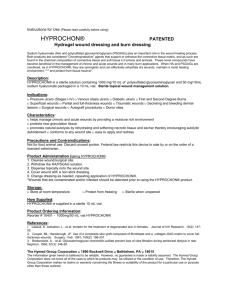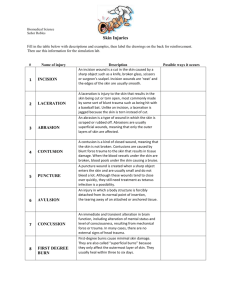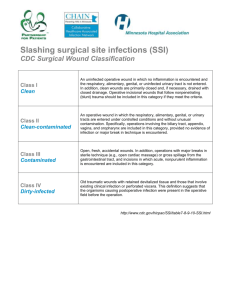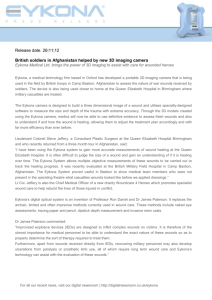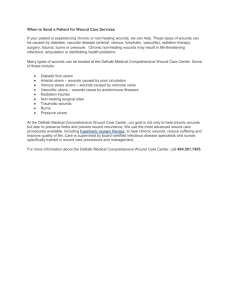WOUNDS, INJURIES AND FIREARMS
advertisement
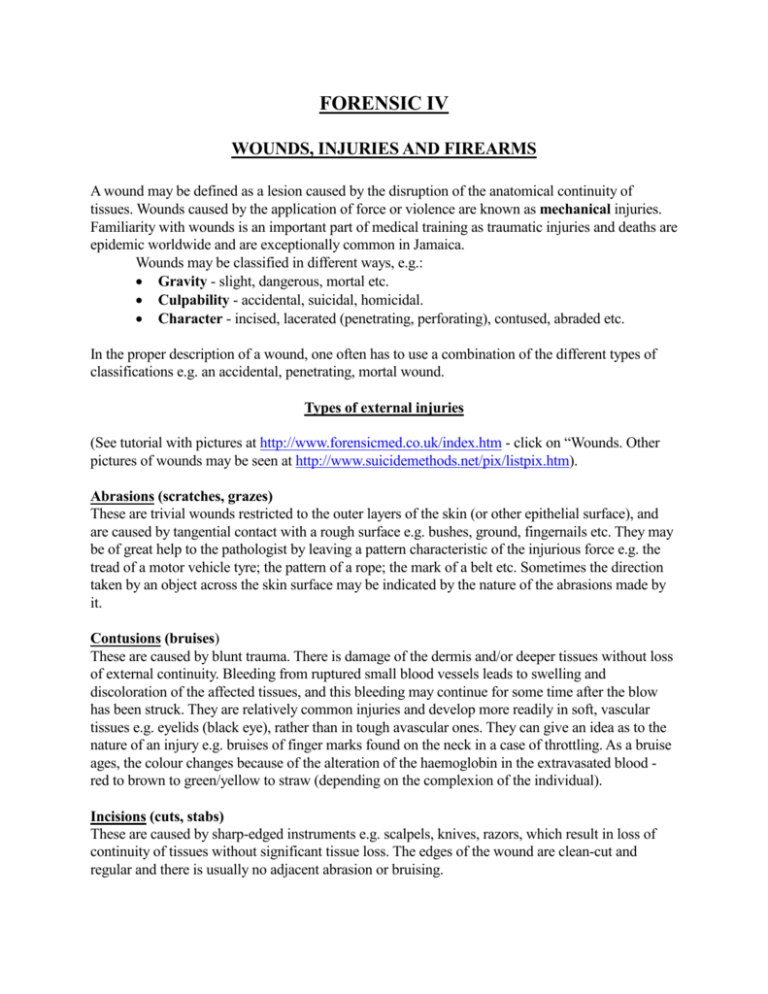
FORENSIC IV WOUNDS, INJURIES AND FIREARMS A wound may be defined as a lesion caused by the disruption of the anatomical continuity of tissues. Wounds caused by the application of force or violence are known as mechanical injuries. Familiarity with wounds is an important part of medical training as traumatic injuries and deaths are epidemic worldwide and are exceptionally common in Jamaica. Wounds may be classified in different ways, e.g.: Gravity - slight, dangerous, mortal etc. Culpability - accidental, suicidal, homicidal. Character - incised, lacerated (penetrating, perforating), contused, abraded etc. In the proper description of a wound, one often has to use a combination of the different types of classifications e.g. an accidental, penetrating, mortal wound. Types of external injuries (See tutorial with pictures at http://www.forensicmed.co.uk/index.htm - click on “Wounds. Other pictures of wounds may be seen at http://www.suicidemethods.net/pix/listpix.htm). Abrasions (scratches, grazes) These are trivial wounds restricted to the outer layers of the skin (or other epithelial surface), and are caused by tangential contact with a rough surface e.g. bushes, ground, fingernails etc. They may be of great help to the pathologist by leaving a pattern characteristic of the injurious force e.g. the tread of a motor vehicle tyre; the pattern of a rope; the mark of a belt etc. Sometimes the direction taken by an object across the skin surface may be indicated by the nature of the abrasions made by it. Contusions (bruises) These are caused by blunt trauma. There is damage of the dermis and/or deeper tissues without loss of external continuity. Bleeding from ruptured small blood vessels leads to swelling and discoloration of the affected tissues, and this bleeding may continue for some time after the blow has been struck. They are relatively common injuries and develop more readily in soft, vascular tissues e.g. eyelids (black eye), rather than in tough avascular ones. They can give an idea as to the nature of an injury e.g. bruises of finger marks found on the neck in a case of throttling. As a bruise ages, the colour changes because of the alteration of the haemoglobin in the extravasated blood red to brown to green/yellow to straw (depending on the complexion of the individual). Incisions (cuts, stabs) These are caused by sharp-edged instruments e.g. scalpels, knives, razors, which result in loss of continuity of tissues without significant tissue loss. The edges of the wound are clean-cut and regular and there is usually no adjacent abrasion or bruising. Lacerations (split wounds) These are produced by tearing or splitting of the tissues and are caused by blunt objects e.g. sticks, stones, or by dull cutting instruments. The wound edges are irregular, there is usually significant tissue loss and the margins are abraded and/or bruised. They are usually found where bone is very close beneath overlying skin e.g. eyebrows and scalp. They may be associated with internal injuries and/or fractures. A cut (or slash) or stab may be incised or lacerated depending on the sharpness of the weapon involved. In a cut, the length of the wound is relatively greater than the depth; in a stab, the depth is usually much greater than the width. In the investigation of wounds on a dead body consideration must be given to: the nature of the causative agent the circumstances in which wounding occurred (the manner of the injury). Nature of agent As mentioned before, bruises, abrasions and lacerations are caused by relatively blunt objects, while cuts and stabs are inflicted by sharper instruments. Be careful about making definitive statements about weapons that might have caused injuries, e.g. with knife wounds, the length of a wound on the skin may be equal to, less than or greater than the width of the knife that inflicted it; similarly, the depth of a stab wound may be equal to, less than or greater than the length of the causative knife blade. Circumstances (manner) of wounding One should try to decide if wounding was accidental, suicidal or homicidal. One should be careful about using the trajectory of the wound track in penetrating injuries in categorically deciding on the relative positions of attacker and victim at the time when the injury was inflicted. These events are often dynamic and the people involved may have been moving, twisting, turning, bending etc, and errors and oversimplifications may occur when wounds examined on a supine dead body are being interpreted. Suicidal These are usually incised, and are cuts, stabs or both. The mortal wound is usually accompanied by several "tentative" or "intention" wounds, which are minor wounds close to the main wound. They are made by the victim as he/she builds up the courage to inflict the fatal injury. Suicidal wounds are usually found in common "target" areas e.g. the neck, the wrists and the front of the chest on the left side. The suicidal cut throat is usually typical. In right-handed people, it starts high up on the left side beneath the angle of the jaw, runs symmetrically across the front of the neck (across the thyro-hyoid ligament) curving down across the midline and turns up for a variable distance towards the opposite ear where the wound becomes more shallow. Tentative wounds are found. Naturally, wounds deemed to be suicidal must be in sites accessible to self-infliction. Page 2 of 8 Homicidal These may be incised, lacerated, contused, or may be a combination of all. Usually the injuries are bold and tend to be similar in severity, and there are no tentative wounds. There may be "defensive" wounds, however, which are protective injuries to the hands and/or forearms inflicted when the victim tries to ward off the fatal wound. Defensive wounds are sometimes quite severe. The homicidal cut throat tends to be a single, deep, asymmetrical wound often towards one side. Accidental There are no characteristic features or distribution of injuries. BURNS Burn injuries are not uncommon. Such injuries may be caused by: (1) Dry heat e.g. flames, application of hot bodies (2) Moist heat e.g. scalds (3) Chemicals e.g. corrosives - acids, alkalis (4) Electricity e.g. electrical mains, lightning (5) Radiation e.g. x-rays In our setting, fatal burns are most often flame burns. Death may be instantaneous due to primary neurogenic shock. In the next few days, death is usually related to fluid and electrolyte imbalance and/or sepsis. One should note that apart from the actual burning, death may occur from, or be contributed to, by asphyxia secondary to smoke inhalation and/or carbon monoxide poisoning due to CO generated by combustion. Postmortem Findings Detailed findings in the different types of burning are beyond the scope of these notes, however, the extent, severity and distribution of the burns must be carefully documented in all cases. In flame burns, burnt areas will be reddened, blistered or charred. The face is swollen and distorted and the tongue often protrudes. The body often presents the characteristic "boxing" or "pugilistic" attitude due to heat stiffening. This occurs because of generalized flexion of the body due to coagulation of muscle proteins. Fractures may be produced by the sudden, powerful contraction of the muscles. Internally, the airways may be blackened by soot and there may be signs of asphyxia. Blood is thick due to haemoconcentration. The skullcap may show fissured fractures secondary to intense heat. In cases of delayed death, there may be evidence of septicaemia or acute renal tubular necrosis. Page 3 of 8 FIREARMS AND FIREARM WOUNDS Details about firearms and ballistics cannot be fully addressed here. For those interested in greater detail and/or great pictures, firearms tutorials may be perused at http://www.forensicmed.co.uk/firearms_tutorial.htm, and this site links to the excellent tutorial on the WebPath site. An excellent shotgun tutorial can be seen at http://science.howstuffworks.com/shotgun.htm. The type of wound produced by a firearm depends on several factors including: a) Nature of the weapon b) Composition of the missile c) Range d) Tissues traversed by the missile e) Direction of fire The Weapon Ballistics is the study of firearms and ammunition. It is a very highly specialized and complex science and cannot be fully discussed here, but certain basic principles can be considered. There are two main types of guns: Those firing single missiles, e.g. rifles and pistols Those firing a mass of small missiles (shot) - shotguns. Rifles and pistols are rifled weapons i.e. there is rifling (spiral grooving) of the inside of the barrel which imparts spin to the bullet, ensuring a stable flight by the gyroscopic effect produced. The long-barrelled weapons (rifles) have a high muzzle velocity and are accurate over a long range (2,000-3,000 yards on average). The short-barrelled weapons (pistols) have a low muzzle velocity and are accurate over a relatively short range (400-600 yards on average). Pistols may be revolvers or automatics (semi-automatics). Revolvers fire bullets from chambers in a revolving metal cylinder. After the bullet is fired, the cartridge case remains in the cylinder and must be removed by hand. The “automatic” is a self-loading weapon, and the ammunition is stored in a magazine in the handle of the gun and is fed into the barrel of the gun as each bullet is fired. After the bullet is fired the empty cartridge case is automatically ejected from the gun. The calibre of these guns is expressed as the internal diameter of the barrel e.g. .38 inch, .45 inch or 9mm. The basic unit of ammunition is the cartridge (or round), made up of the cartridge case, the primer, the powder and the bullet. Bullets are made of hard solid metal and fit into a cartridge case (usually brass) that contains the powder, which explodes when the firing pin on the hammer of the gun hits the cartridge case and ignites the primer, forcing the bullet from the gun. Hollowing out the Page 4 of 8 tip of the bullet (hollow-points; dum-dums) causes the bullet to shatter or deform on contact causing greater damage. Shotguns have a smooth bore i.e. the inside of the barrel is smooth. The gun fires a cartridge composed of a mass of lead pellets which fan out after being fired. The effect at close range is that of one solid missile, but at a distance it is that of several individual pellets. A bullet fired from a rifled gun bears scoring (scratches) imparted by the inside of the barrel. This scoring is characteristic of the weapon, providing a "fingerprint" which can be used to identify the weapon from which a bullet was fired. It is therefore important that bullets recovered at autopsy should NEVER be handled directly by metal forceps or other hard instruments which might alter the scoring pattern. Such bullets should be wrapped in protective wadding for transportation to the forensic laboratory. Note that the cartridge case bears marks produced by the firing mechanism from which it is possible to identify the gun that was used. It should also be treated with great care. Bullet Wounds Entry Wounds The features vary depending on the range from which the weapon is fired—contact, close (intermediate) range or longer (indeterminate) range. A gunshot wound is a controlled explosion and the bullet is accompanied from the gun by a jet of flame, a cloud of gas, burning and unburnt grains of gunpowder and soot from burnt gunpowder. Entry wounds may show the stigmata of the explosion to a lesser or greater extent. Page 5 of 8 (A) Contact wound The muzzle is pressed against the skin. The heat of the discharge causes scorching or charring of the wound. The gases produced by the explosion of the cartridge enter, stretch and split the skin producing a stellate or cruciform tear. The tissue at the margin of the wound may contain soot and powder. (B) Close range (Intermediate range) The wound is inflicted at less than arm's length i.e. < 2 - 3 feet. The particles of partly burnt or unburnt powder from the muzzle are driven into the skin around the entrance wound giving a stippled appearance called "powder tattooing" or "powder burns". The area may be blackened by soot. Soot may be wiped off the skin, but powder tattooing cannot be wiped off. The bullet hole may be round or split, the latter being relatively common when there is underlying bone. (C) Longer (Indeterminate) `range The range is > 2 - 3 feet. The gun is too far from the skin for the products of the explosion to have any effect. Therefore the appearance of the wound is due entirely to the bullet. The wound is usually round (but may be split by "tail-wag" if the gun is fired from the extreme of its effective range causing the bullet to lose its gyroscopic spin and start to tumble). Marginal abrasion/Abrasion collar/Abrasion ring The margin of the entry wound in some close range and longer range injuries may be abraded (“marginal abrasion”, “abrasion collar” or “abrasion ring”) as the bullet inverts the skin and abrades the epidermis as it enters. The shape of this abrasion may help in determining trajectory. Grease ring The inner edge of the abrasion collar may be black due to grease or lubricating oil and metal particles from the bullet. Exit wounds These show none of the stigmata of the explosion or soiling seen in the entry wound. An exit would may be the same size as the entry wound, but may be smaller or larger depending on the range, type of weapon, type of bullet, the tissues being traversed by the bullet, etc. In a contact shot the entry wound is split by the explosive gases and is therefore usually larger than its corresponding exit wound. However, if the bullet comes out carrying bone e.g. a shot to the skull, the exit wound may be larger than the entry. In a distant shot the exit wound may be the same size or slightly smaller than the entry. In general, exit wounds tend to be split with irregular, everted edges. As a rule, exit wounds DO NOT show an abrasion collar, but exceptionally, this may occur if the skin was pushed up against a hard surface, e.g. concrete wall or floor at the time the bullet exited. This is known as a shored exit wound. Page 6 of 8 Bullet wounds of the skull are peculiar in that they produce entry and exit wounds in the bones of the skull as well as the skin. The entrance wound to the skull is bevelled (angled) inward (i.e. the hole gets bigger as it goes into the skull!), because the hole in the inner table of the skull has a greater diameter than that in the outer. This happens because the bone fragments from the outer table travel inward with the bullet, amplifying its effect. In contrast, the exit wound from the skull is bevelled outward (i.e. the hole gets bigger as it goes out of the skull), because the hole in the outer table now has a greater diameter than that in the inner. This is also caused by the amplifying effect of bone fragments travelling with the bullet. In a close range shot to the head the exit wound may be quite large. Shotgun wounds cause massive destruction with contact or close injuries. There is accompanying blackening and singeing of the wound. As the range increases, many tiny separate holes will be seen. Exit wounds are uncommon, except at relatively close range, as the shot tend to scatter within the body. Blunt Trauma to the Skull This can result in a variety and combination or injuries, including: Skull fractures - may be compound, depressed, single, multiple etc. Remember that fatal head injury can occur without skull fractures. Intracranial haemorrhage - extradural (epidural), subdural, subarachnoid. Subarachnoid haemorrhage is quite common but is not usually the only injury found in trauma. When it is the only finding it is more likely to be the result of spontaneous rupture of a berry aneurysm. Brain damage - contusion and laceration may occur. The latter may cause intracerebral haemorrhage. Cerebral oedema is common and may lead to fatal raised intracranial pressure. Concussion produces unconsciousness without gross brain damage, but microscopic examination may show neuronal injury with demyelination. Page 7 of 8 Interpretation and Documentation of Injuries A proper description is essential—wounds must be documented as to their number, size, shape and dimensions. With firearm wounds, the number of entry and exit wounds must be recorded (try to pair up entrance and exit wounds) and the path (track) of the injury described (this is also true of a stab wound). Bullets must be recovered if they are in the body, and the body might have to be x-rayed to expedite this. Be cognizant of the probable type of weapon that could have caused the injury. In the case of a firearm wound one should be able to give an idea of the range of discharge. Strive to determine the precise cause of death. Sensible comment must be made as to the probability of the wound(s) being homicidal, suicidal or accidental. Before attending court to give evidence, review the notes on the relevant case to come to some conclusion as to important opinions such as the nature of the weapon, the range of discharge of a firearm, the exact cause of death, the probable position of the assailant with respect to the victim etc. CTE/cte Jan 2007 Page 8 of 8



